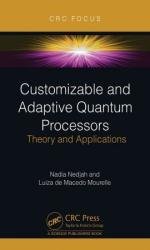 Название: Customizable and Adaptive Quantum Processors: Theory and Applications
Название: Customizable and Adaptive Quantum Processors: Theory and ApplicationsАвтор: Nadia Nedjah, Luiza de Macedo Mourelle
Издательство: CRC Press
Год: 2023
Страниц: 137
Язык: английский
Формат: pdf (true)
Размер: 10.2 MB
This book provides a representation of the state-of-the-art simulators and emulators that can be used for quantum computing. It especially reports a customizable and adaptive hardware design of a quantum processor that can be implemented in field programmable gate arrays to aid the traditional host processor to accelerate some computations and execute quantum algorithms. In the following, we give a brief description of the main contribution of each of the included chapters.
In the first chapter, entitled “Introduction to Quantum Computing”, we introduce the motivation behind this book and we present and comment of recent related works in the literature about the quantum computing emulation by hardware and simulation by software. We also present the organization of the remaining chapters of the book.
In the second chapter, entitled “Quantum Concepts”, we first introduce the main characteristics on the basis of quantum computing. After that we define and give illustrative examples for all the basic concepts that build the foundations of quantum computing. So, we define the indivisible piece of information that substitutes the traditional bit in the well-known classical computing paradigm. In the sequel, we explain and exemplify the parallelism behind any quantum-related computation. Subsequently, we describe the process of quantum information sampling also know as measurement of the quantum state of a given piece of information. Last but not the least, we explain the process of quantum bit entanglement, collapsed state as well as the process of information cloning in contrast to information copying in the traditional computing paradigm.
In the third chapter, entitled “Quantum Operators”, we first introduce the concept of quantum operators. After that, we define the main tensor product operation, which is behind almost all quantum information manipulation. Subsequently, we present existing unitary, binary and ternary quantum operators as well as the computation implied by every one of the presented operators. We also explain that the tensor product is not an end calculation in a quantum operation, it has significant importance due to the overall number of multiplications with complex numbers that it requires. We prove that this number increases exponentially with the number of quantum bits involved in the quantum state. We show that if not handled efficiently, it would require a lot of memory space, which makes the design emulating a quantum processor quite expensive to produce.
In the fourth chapter, entitled “Quantum Processor Macro-architecture”, we present the overall hardware architecture of a quantum processor.
In the fifth chapter, entitled “Calculation Unit Micro-architecture”, we first give an overall view regarding the function that must be executed by the calculation unit. We present and explain the underlying micro-architecture of this functional unit.
In the sixth chapter, entitled “Control Unit Micro-architecture”, we present the control unit of the processor. We first describe the micro-architecture of this unit and define the main control components required to implement the execution of the quantum micro-instructions.
In the seventh chapter, entitled “Quantum State Measurement”, we propose a possible simple yet efficient implementation of the quantum state sampling unit. First, we present the idea behind the solution. Then, we describe and explain the micro-architecture of the measurement unit. It performs the measurement of the quantum state using the roulette selection algorithm and pseudo-random number generator.
In the eighth chapter, entitled “Quantum Instruction Simulation”, we give proof of the correct operation of the proposed processor. For this purpose, we present a simulation about every aspect of the quantum processor while executing a quantum instruction. We recall the main elements of a quantum instruction and their usage during the execution process.
In the ninth chapter, entitled “Book Final Remarks”, we draw some final considerations about the book and point out some directions on how to improve the current state of the art of quantum computing simulators/emulators.
Скачать Customizable and Adaptive Quantum Processors: Theory and Applications